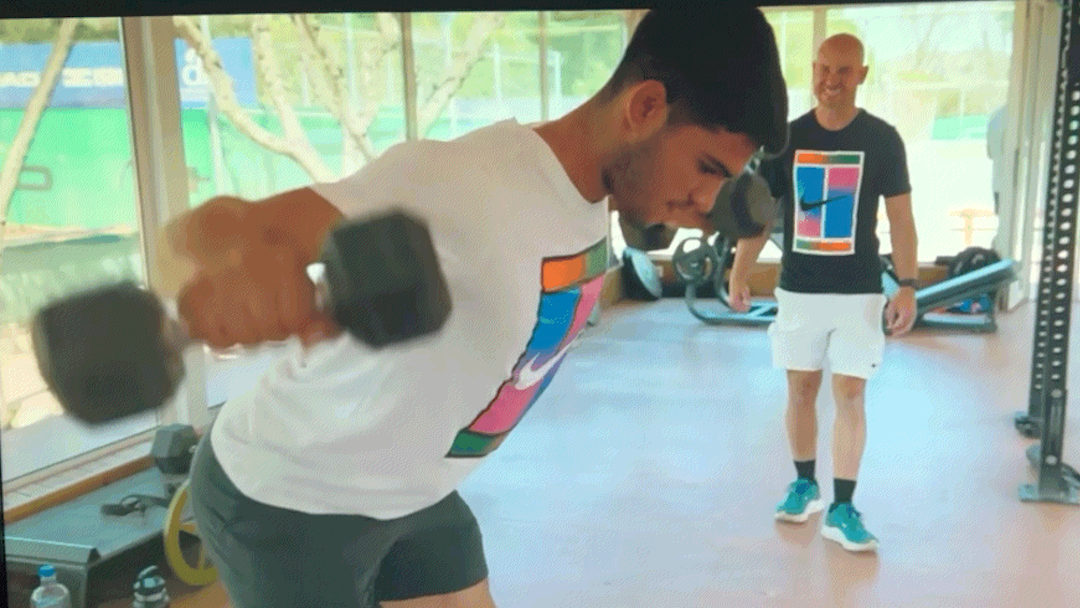This is the final tennis training post derived from the Netflix docuseries “Break Point.” This marathon series officially launched on February 28, 2023 and has run every Tuesday since then. At the time, I innocently thought these posts would run a few weeks and then I would move onto something else. Suffice it to say that I significantly underestimated the material the show would provide.
In last Tuesday’s penultimate post in this series, I noted the presence of a couple of “speed ladders” marked out on the floor behind a scene of Aryna Sabalenka smashing a racquet after losing to Coco Gauff in the US Open Finals. Technically, there are actually three-speed ladders visible the screenshot. The two I wrote about last week were the standard box grid form, ubiquitous in every sport where speed and agility are essential. However, a tennis-specific speed ladder also appears in this scene.

Directly behind Sabalenka is a straight line with tick marks at what might initially appear to be odd intervals. However, carefully examining the proportions reveals that the dimensions are precisely the placement of the vertical lines on a tennis court. The doubles alley is marked at the far end, and the center line appears in the middle. This scene was shot with a telescopic lens, compressing depth perception. However, I am certain these are the tennis court lines. It is the first time I have seen this tennis-specific speed ladder marked off in this way outside a tennis court.
The discovery of this new type of speed ladder is not without emotional baggage. In my junior development days, lining the kids up on the outside of one of the doubles alleys and having us execute a series of short sprints by “running the lines” was ubiquitous. It is not hyperbole when I say I was scarred for life from running the lines. The simple fact of the matter is that I am dog-slow. The worst variation of running the lines was a series of successive races where the “winner” of each heat got to drop out. That was essentially the same thing as the coach pointing at me and telling me that I would be running a set of lines for the total number of kids in attendance that day.
Footwork is the foundation of good tennis. The ability to move quickly and efficiently can be the difference between winning and losing a point. Consequently, agility training that targets speed, balance, and coordination should be a priority for any serious tennis competitor. Incorporating drills that enhance rapid foot movements helps refine the quick adjustments needed during tennis matches, allowing players to position themselves effectively and reach challenging shots.
Specifically, “running the lines” is an excellent conditioning tool for tennis players to improve lateral movement, balance, and explosive speed. It mimics the precise dimensions of the court. Consequently the sucessive sprints are tailored to the physical demands of playing points. By integrating this drill into their training routine, players can develop sharper change of direction, court awareness, and the ability to put their body where it needs to be to effectively hit the ball.
Since the only place I have ever glimpsed this kind of speed ladder is on the US Open training room floor, there aren’t any obviously commercial options that I am aware of for implementing this in your training space. If you have a need or desire to do this in a gym setting, it will be a DIY project. The easiest way to do it might be to use an existing line on a gym floor and mark out the intervals using ticks of painters tape.
Last week I advocated for the use of a speed ladder to enhance your agility training. This tennis-specific alternative is also great for building a foundation of great court movement. In a sport where milliseconds count, even small gains in agility can make a big difference. This unique variation of the speed ladder could be key to stepping up your footwork—one sprint at a time.
Fiend At Court participates in the Amazon associates program and receives a paid commission on any purchases made via the links in this article. Details on the disposition of proceeds are available on the “About Fiend at Court” page.



